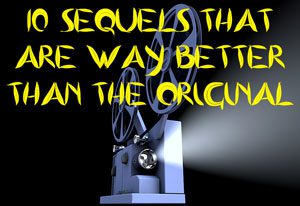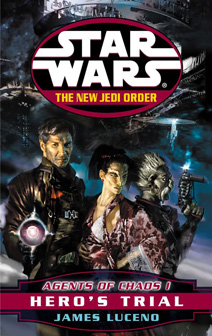James Luceno seemed like a “Star Wars” author before he actually was a “Star Wars” author, due to his friendship with Brian Daley (with whom he wrote the “Robotech” series). But even with that goodwill in his back pocket, Luceno impressed me and many other fans with his debut novel, “Agents of Chaos I: Hero’s Trial” (2000), the fourth entry in the “New Jedi Order” series.
I remembered two elements from my first reading: Han’s banter and newfound friendship with a Ryn named Droma, and the fact that Luceno’s writing feels very much like Daley’s “Han Solo Adventures” trilogy. Those traits were still front-and-center on this re-read. Han’s trading of insults and sardonic observations with Droma is so entertaining that I thought for sure the “NJO” team was setting him up to be Han’s new co-pilot in the wake of Chewbacca’s death, just as the Togorian, Muuurgh, was Han’s co-pilot before he met Chewie, back in A.C. Crispin’s “Paradise Snare.” As it turned out, the shapers of the “NJO” went a different direction, making Leia the co-pilot, which in retrospect makes a lot of sense.
Still, Droma is one of the best original-to-the-EU characters. Despite a horrible lot in life (he’s stuck on the Jubilee Wheel space station off Ord Mantell, separated from his family), he has a positive attitude and adventurous spirit. Droma influences Han to rediscover his own passion for life, as Luceno proves a character is never too old for a call-to-adventure yarn. Indeed, digging into Han’s character was a primary impetus behind the “NJO” and the decision to kill of Chewie, whose memorial service on Kashyyyk kicks off “Hero’s Trial.”
While Zahn, Stackpole and Anderson were already great at referencing other EU works, Luceno immediately steps up as the master of the form. Han’s old pal Roa (“The Hutt Gambit,” “Han Solo’s Revenge”) inspires him to investigate the Peace Brigade, a group of traitorous mercenaries who work with the Yuuzhan Vong against the New Republic. And Big Bunji (“Han Solo at Stars’ End”) is a source of information. Rather than mere name-drops, Han’s interactions with these old acquaintances flow smoothly into the narrative.
And when Luceno cites Han’s traits, he doesn’t just draw from the movies, as a lesser author would do. On page 266, Luke cites something Obi-Wan observed about Han in Daley’s “Star Wars” radio drama:
“Obi-Wan said something I’ll never forget. He said there was more to Han than met the eye, and that he had real substance beneath his callous front. Obi-Wan also said that only a special person would have a Wookiee for a companion – and that not just any Wookiee would be found roving the galaxy in the company of someone like Han.”
There are other elements that fall closer to fan-service name-dropping, but I still dug it when – for example – Luceno brings up Tanith Shire, a long-forgotten (except by die-hard fans) character from the Goodwin/Williamson strips (p. 67-68):

Mara: “Akanah, Gaeriel Captison, Callista … Luke Skywalker’s lost loves. Not to mention that one on Folor …”
Luke: “Fondor. And I was never in love with Tanith Shire.”
(Still, the fact that Luke told Mara about Tanith shows that he at least remembers her.)
And while something like Han getting into a fistfight with Bossk – who insults Chewbacca — is unquestionably contrived, it is deliciously contrived.
Granted, Luceno has to play fast and loose with some of the dumber aspects of previous stories. For example, since Cighal brought Mon Mothma back from the brink of death in the “Jedi Academy Trilogy,” one might think she could do the same for Mara, but that’s not the case. Mara does get healed in “Hero’s Trial,” though, and the cure comes thanks to the tears of another Jedi (although we don’t yet know she’s a Jedi) — Vergere, the companion of a Yuuzhan Vong “defector” named Elan.
In an example of in-universe synergy not seen since the “Ewoks” and “Droids” comic crossover in the 1980s, Del Rey published “Hero’s Trial” simultaneously with “Rogue Planet,” Greg Bear’s post-“Episode I” novel in which Vergere meets Anakin and Obi-Wan before leaving the galaxy with the Vong to learn more about them. A member of the bird-like Fosh species (I picture a female version of the country chicken lawyer from “Futurama”), she’s an intriguing mystery for now, but she’ll play a bigger role in “Traitor,” later in the “NJO.”
Luceno moves ideas forward while respecting past stories. A lesser author (cough, cough, Anderson) might be content to mimic lines from the movies, or repeat them wholesale, but Luceno understands that people’s lives are not repetitions of catchphrases. He also understands that droids – provided their memory isn’t wiped – can learn just like sentient beings. So C-3PO, rather than giving yet another lecture on long odds, informs R2-D2 that Han has proven once again that long odds can be overcome. Unfortunately, I don’t think other authors picked up on the concept of giving an arc to 3PO (who worries about death in this book), but Luceno provides the best droid characterization this side of Michael Reaves’ work with I-Five.
Luceno’s only flaws are that his space dogfights and battles are generic, and his specific war strategies can get muddled. In “Hero’s Trial,” the Vong have Elan and Vergere pose as defectors so they’ll have agents inside the New Republic. Then the Peace Brigade, built up off-page by Nom Anor for other reasons, decides to curry more favor by returning Elan and Vergere to the Vong, not realizing the Vong purposely let them go. So in the climactic battle, the Vong have to lose a fight to the New Republic without making it obvious that they are trying to lose. (“Keep your distance, Chewie. But don’t look like you’re trying to keep your distance.”)
With the introduction of yet another sect within Vong culture – the priest class, led by Harrar – it seems the eventual demise of the Vong will come from internal rivalries and different sects working at cross purposes.
While “Hero’s Trial” isn’t exactly light on Yuuzhan Vong material – for example, we learn about a suctioning creature that whisks hapless beings out of ships and space stations to become slaves and sacrifices – this novel ultimately feels like a throwback to less dark and dire times. As Han finds himself again, repairs his relationships and realizes he can go on without his best friend, so too does the “Star Wars” book series rediscover its spirit of adventure.
As we’ll learn from his catalog going forward, Luceno wasn’t just channeling Daley; he’s a great scribe – and “Star Wars” historian — in his own right.

